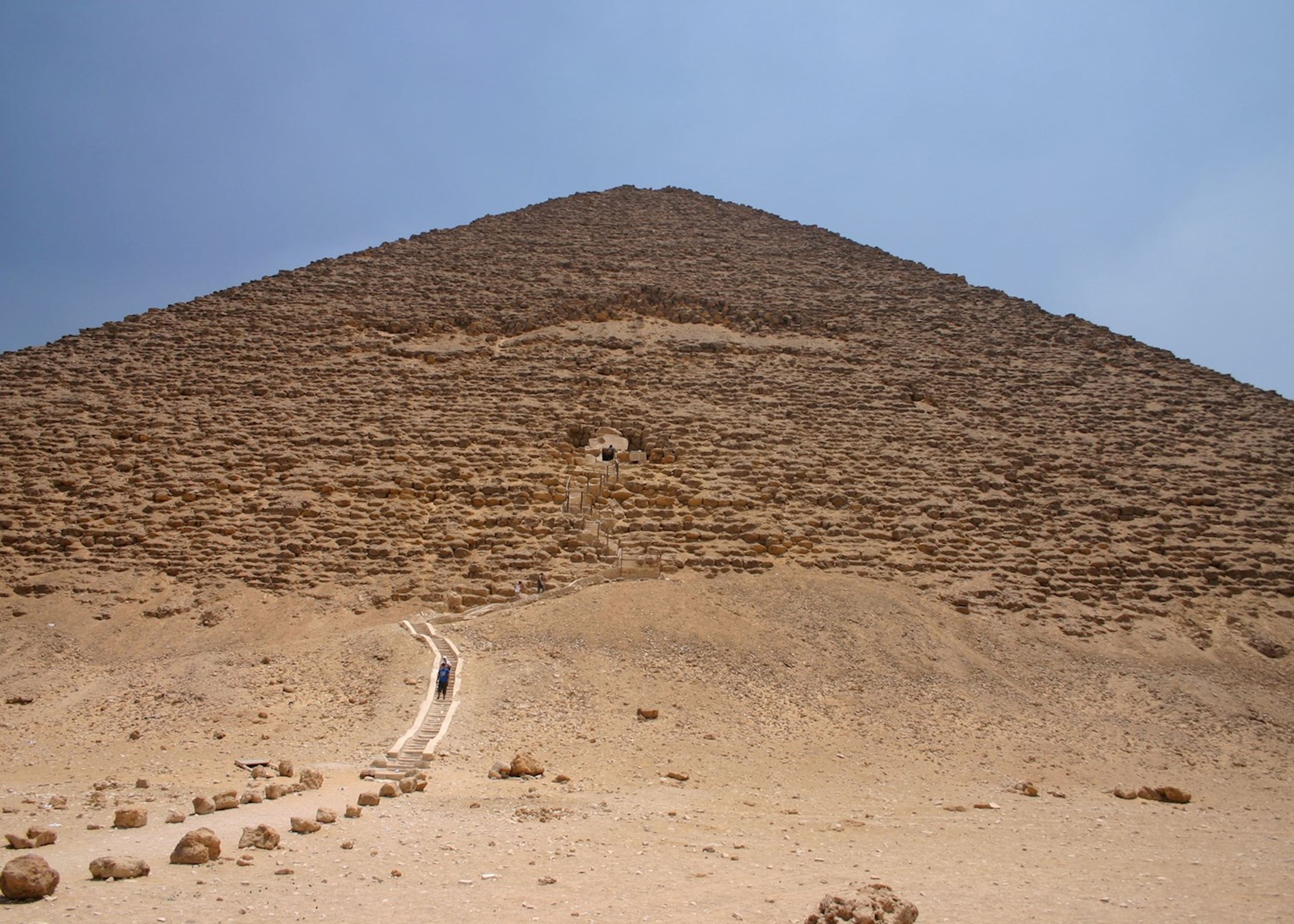Dahshur's Red Pyramid: A Wonder of the Ancient World

If you are fascinated by ancient wonders and want to explore past marvels, Dahshur's Red Pyramid is a must-visit destination. This architectural masterpiece is visually stunning and holds great historical significance. Let's delve into the intriguing world of Dahshur's Red Pyramid and discover what makes it a wonder of the ancient world.
Introduction to Dahshur's Red Pyramid and its Significance
Dahshur's Red Pyramid stands tall in the desert landscape of Egypt, just south of Cairo. Built during the reign of Pharaoh Sneferu, it is considered Egypt's first true smooth-sided pyramid and a precursor to the iconic Pyramids of Giza.
Engineering Marvel: The Red Pyramid is renowned for its exceptional engineering techniques, showcasing the advancement of ancient Egyptian architecture. Its precise construction, symmetrical design, and perfectly angled sides reflect the skilled craftsmanship of the time.
Historical Significance: As the final resting place of Pharaoh Sneferu, the Red Pyramid holds immense historical value. It represents a pivotal moment in ancient Egyptian history when monumental pyramids began to replace older mastaba tombs.
Rare Access: Unlike some other famous pyramids in Egypt, visitors have the unique opportunity to explore and climb inside the Red Pyramid. Venturing through its narrow passageways and ascending to its chambers allows you to follow ancient pharaohs' footsteps.
Breathtaking Views: Standing at an impressive height of 341 feet, the Red Pyramid offers awe-inspiring views of the surrounding desert landscape. From its peak, you can appreciate the vastness of Egypt's expansive terrain and imagine what life was like during its construction.
Whether you're an avid history enthusiast or captivated by ancient wonders, Dahshur's Red Pyramid is an unforgettable experience. This awe-inspiring masterpiece will transport you back in time and leave you in awe of the remarkable achievements of the ancient Egyptians.
History of Dahshur's Red Pyramid
Overview of the historical background and construction of the Red Pyramid
The Red Pyramid in Dahshur, Egypt, is a fascinating piece of ancient history. Built during the reign of Pharaoh Sneferu, who ruled during the Old Kingdom period of ancient Egypt, this pyramid holds significant historical and architectural importance.
The construction of the Red Pyramid began around 2600 BC and is believed to be one of the earliest successful attempts at building a true pyramid. Its red limestone blocks give the pyramid its name, differentiating it from other pyramids in Egypt.
Pharaoh Sneferu commissioned the construction of this pyramid as his final resting place. It was built as an improvement over previous pyramid designs, with smooth, straight sides that rise at an angle of about 43 degrees. The Red Pyramid is a testament to ancient Egyptians' skill and expertise in pyramid construction.
One unique feature of the Red Pyramid is its internal structure. It was designed with two entrances, one on the north side and another on the west side, leading to a series of interconnected chambers and corridors. These chambers were intended to house Pharaoh Sneferu's sarcophagus and funerary goods.
The construction techniques used to build the Red Pyramid were innovative. Pharaoh Sneferu's architects incorporated lessons from previous pyramid constructions, resulting in a more stable structure that withstood the test of time.
Today, visitors can explore the inside of the Red Pyramid and marvel at its impressive architecture and ancient history. It stands as a testament to the ingenuity and achievements of ancient Egyptian civilization, offering a glimpse into their rich cultural heritage.
The Red Pyramid in Dahshur reminds us of the grandeur and legacy left behind by the pharaohs of ancient Egypt. Its historic significance and architectural excellence make it a must-visit destination for history enthusiasts and travellers alike.

Architectural Features of the Red Pyramid
The Red Pyramid in Dahshur, Egypt, is a true wonder of the ancient world. Its unique architectural features and design elements make it a must-see for history enthusiasts or travellers. Here are some key points to help you appreciate the beauty and ingenuity behind this incredible structure.
Explanation of the unique architectural features and design elements of the Red Pyramid
-
The Smooth Red Limestone: The entire pyramid is built with high-quality limestone, giving it its distinctive red colour. This smooth outer surface gives the pyramid an impressive appearance.
-
The Bent Pyramid Shape: The Red Pyramid is one of the few examples of a pyramid with a bent shape. This unique design element sets it apart from other pyramids in Egypt. The angle change is believed to have resulted from construction challenges or changes in design during its construction.
-
Interior Layout: The interior of the Red Pyramid consists of a series of passageways leading to multiple chambers. The main burial chamber, located at the bottom of the pyramid, is where the pharaoh's sarcophagus would have been placed.
-
The Ventilation Shaft: One fascinating aspect of the Red Pyramid is its ventilation system. The architects cleverly incorporated a shaft that allows fresh air to circulate throughout the structure, ensuring a comfortable environment for the occupants.
-
Sturdy Construction: Despite its age, the Red Pyramid has remarkably stood the test of time. Its solid construction using precisely cut stones and well-designed mortise and tenon joints demonstrates the advanced engineering skills of ancient Egyptians.
Visiting Dahshur's Red Pyramid is like stepping back in time and witnessing an incredible feat of ancient engineering and architecture. It's truly a marvel that continues to awe visitors worldwide.

Interior of the Red Pyramid
Welcome to Dahshur's Red Pyramid, one of the wonders of the ancient world! If you're planning a visit, you're in for a treat. Let's explore the magnificent interior and unveil the secrets that lie within.
Exploration of the interior chambers, passages, and burial chambers within the Red Pyramid
Once you enter the Red Pyramid, prepare for an awe-inspiring journey. As you go through the labyrinthine passages, you'll be transported back in time to a world of ancient majesty.
The interior chambers are a testament to the engineering skills of the ancient Egyptians. Marvel at the well-preserved craftsmanship as you walk through corridors adorned with hieroglyphics and intricate carvings. These intricate designs tell stories of pharaohs and their quest for immortality.
Venturing further, you'll come across the burial chambers. These sacred spaces were intended to house the remains of pharaohs and hold precious treasures. Imagine the grandeur and significance of these chambers as you stand in their presence.
As you navigate through narrow passages and ascend steep staircases, don't forget to look up and admire the impressive architecture. The pyramid's interior is an architectural marvel, showcasing the precision and ingenuity of its construction.
Exploring Dahshur's Red Pyramid provides a unique opportunity to immerse yourself in ancient Egyptian history. It's a chance to witness firsthand the remarkable achievements of a civilization that flourished thousands of years ago.
So, if you're fascinated by history and crave an adventure, include Dahshur's Red Pyramid in your travel plans. Step into the past, unlock its mysteries, and marvel at the wonder of the Red Pyramid. You won't be disappointed!

Importance of the Red Pyramid in Ancient Egypt
The Red Pyramid at Dahshur holds a significant place in the history of ancient Egypt. Let's explore the cultural and historical significance of this marvellous structure.
Discussion on the cultural and historical significance of the Red Pyramid in ancient Egyptian society
- Architectural Marvel: The Red Pyramid, also known as the North Pyramid, is an architectural wonder that stands as one of the earliest true pyramids in Egypt. Built during the reign of Pharaoh Sneferu, it served as a precursor to the famous pyramids at Giza. Its unique red limestone construction sets it apart from other pyramids in Egypt.
- Pharaoh Sneferu's Legacy: The Red Pyramid was commissioned by Pharaoh Sneferu, who significantly shaped ancient Egyptian civilization. As Sneferu's final resting place, this pyramid represents his power, authority, and contribution to Egyptian society and culture.
-
Influence on Pyramid Construction: The Red Pyramid revolutionized pyramid-building techniques, serving as an important milestone in the evolution of pyramid architecture. It provided invaluable lessons in engineering and design that were passed down to future generations of pyramid builders.
-
Religious Significance: In ancient Egypt, pyramids held immense religious importance. They were believed to be the gateway for the pharaohs' souls to ascend to the afterlife. The Red Pyramid's existence and purpose reflect ancient Egyptians' spiritual beliefs and practices.
-
Tourist Attraction: Today, the Red Pyramid is a popular tourist attraction, drawing visitors worldwide to marvel at its grandeur and historical significance. It serves as a testament to ancient Egyptian civilisation's enduring legacy and ingenuity.
The Red Pyramid at Dahshur holds great cultural and historical significance. It represents the architectural achievements, religious beliefs, and legacy of Pharaoh Sneferu. Visiting this remarkable structure provides a glimpse into ancient Egypt's rich and fascinating world.

Comparison with other Pyramids in Egypt
Regarding ancient wonders, Dahshur's Red Pyramid stands tall among the rest. As you explore the marvels of Egypt, it's important to understand how this pyramid compares to other famous pyramids, such as the Great Pyramid of Giza.
Comparison of the Red Pyramid with other famous pyramids in Egypt, such as the Great Pyramid of Giza
-
Affordability: While visiting the Great Pyramid of Giza may cost you a hefty sum, exploring the Red Pyramid is comparatively more budget-friendly. It offers an incredible experience without breaking the bank.
-
Accessibility: The Red Pyramid provides a unique opportunity to explore its interior, including descending into its ancient tombs. On the other hand, access to the interior of the Great Pyramid of Giza is restricted, limiting your exploration experience.
-
Impressive Scale: The Great Pyramid of Giza may be taller and larger, but the Red Pyramid is not far behind. Standing at 330 feet, it still holds its ground as one of the largest pyramids in Egypt.
-
Ancient Engineering Feat: Both pyramids showcase the remarkable engineering skills of their time. The smooth surfaces and precise angles of the Red Pyramid display the mastery of ancient builders.
-
Crowds and Tourists: The Great Pyramid of Giza attracts many tourists, resulting in overcrowded visitation. In contrast, the Red Pyramid offers a more serene atmosphere where you can explore at your own pace without feeling overwhelmed.
While each pyramid has its unique qualities, visiting the Red Pyramid can provide you with an extraordinary experience at a more accessible and affordable level. So, consider adding this wonder to your itinerary and witness the awe-inspiring beauty of ancient Egypt.

Restoration and Preservation Efforts
When visiting the ancient wonder of Dahshur's Red Pyramid, you may wonder how this magnificent structure has managed to withstand the test of time. The answer lies in the extensive restoration and preservation efforts to maintain its grandeur.
Information on the restoration and preservation efforts undertaken to maintain the Red Pyramid
-
Masonry Restoration: Over the years, various restoration projects have focused on repairing and reinforcing the pyramid's masonry. This involves carefully examining the stones for damage, removing loose fragments, and replacing missing or deteriorated blocks to ensure the structural integrity of the pyramid.
-
Mortar Consolidation: One of the key challenges in preserving ancient structures is preventing further degradation caused by weathering and erosion. To address this, experts have utilized techniques such as mortar consolidation, where a specialized adhesive is applied to stabilize loose or crumbling mortar joints.
-
Structural Support: To counteract the effects of seismic activity and shifting soil, measures have been taken to provide additional support to the Red Pyramid. This includes installing steel rods or braces within the internal structure to strengthen stability and prevent potential collapse.
-
Environmental Monitoring: Continuous monitoring of the environment surrounding the pyramid is essential for its long-term preservation. Changes in humidity, temperature, or moisture levels could lead to deterioration. Therefore, sensors track these conditions and ensure appropriate measures are taken to mitigate potential damage.
-
Accessible Viewing: While preservation is crucial, efforts have also made the Red Pyramid accessible for visitors. Safe pathways and viewing platforms have been established, allowing people to appreciate this wonder of the ancient world up close while respecting its delicate structure.
By investing in restoration and preservation efforts, authorities have ensured that future generations can continue to marvel at the awe-inspiring beauty of Dahshur's Red Pyramid. It is a testament to human ingenuity and the importance of preserving our historical treasures for years.

Visiting the Red Pyramid
If you're a history enthusiast or appreciate the wonders of the ancient world, visiting Dahshur's Red Pyramid should be at the top of your travel bucket list. This remarkable pyramid, built during the reign of Pharaoh Sneferu, is a testament to ancient architectural mastery.
Practical details for visitors, including opening hours, ticket prices, and tips for exploring the Red Pyramid
Opening Hours: The Red Pyramid is open daily to visitors from 8:00 AM to 4:00 PM. It's advisable to arrive early to beat the crowds and fully enjoy this awe-inspiring site.
Ticket Prices: The entrance fee for the Red Pyramid is included in the general admission ticket for Dahshur, which costs XYZ. Please note that ticket prices may vary depending on your nationality, so it's best to check with the local authorities or tour operators beforehand.
Tips for exploring the Red Pyramid:
-
Dress comfortably: The exploration of the Red Pyramid involves climbing down a series of narrow passageways, so wear comfortable clothes and sturdy footwear.
-
Carry a flashlight: The pyramid's interior can be quite dark, especially in certain areas. A flashlight will help you navigate the chambers and admire the intricate architectural details.
-
Respect the rules: As with any historical site, it's important to respect the authorities' rules and regulations. Avoid touching or damaging any ancient artefacts or structures, and ensure you follow any guidelines provided by the tour guides or signage.
-
Enjoy the view: Once you reach the top of the pyramid, take a moment to soak in the breathtaking panorama of Dahshur and its surrounding landscapes. It's a sight you won't want to miss!
Visiting Dahshur's Red Pyramid is like stepping back in time and immersing yourself in the legacy of the ancient Egyptians. So, prepare to be amazed and plan your visit to this wonder of the ancient world!
